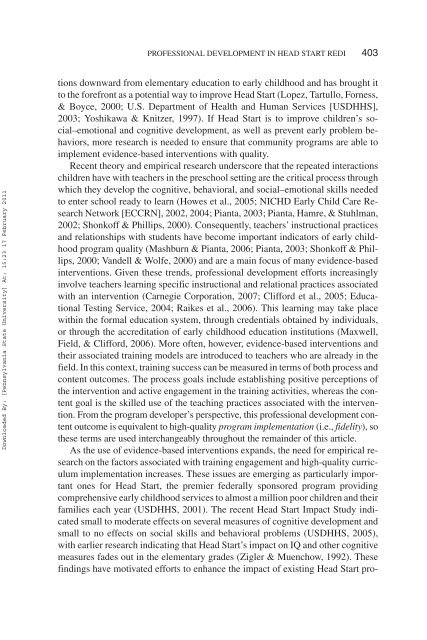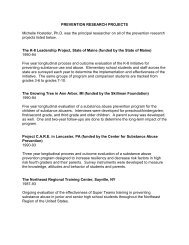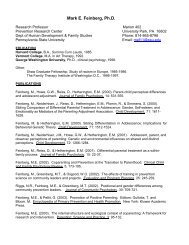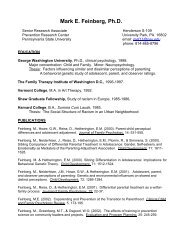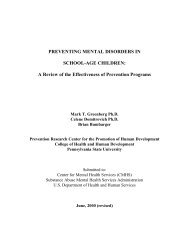Early Education & Development Individual Factors Associated With ...
Early Education & Development Individual Factors Associated With ...
Early Education & Development Individual Factors Associated With ...
You also want an ePaper? Increase the reach of your titles
YUMPU automatically turns print PDFs into web optimized ePapers that Google loves.
PROFESSIONAL DEVELOPMENT IN HEAD START REDI 403<br />
Downloaded By: [Pennsylvania State University] At: 15:23 17 February 2011<br />
tions downward from elementary education to early childhood and has brought it<br />
to the forefront as a potential way to improve Head Start (Lopez, Tartullo, Forness,<br />
& Boyce, 2000; U.S. Department of Health and Human Services [USDHHS],<br />
2003; Yoshikawa & Knitzer, 1997). If Head Start is to improve children’s social–emotional<br />
and cognitive development, as well as prevent early problem behaviors,<br />
more research is needed to ensure that community programs are able to<br />
implement evidence-based interventions with quality.<br />
Recent theory and empirical research underscore that the repeated interactions<br />
children have with teachers in the preschool setting are the critical process through<br />
which they develop the cognitive, behavioral, and social–emotional skills needed<br />
to enter school ready to learn (Howes et al., 2005; NICHD <strong>Early</strong> Child Care Research<br />
Network [ECCRN], 2002, 2004; Pianta, 2003; Pianta, Hamre, & Stuhlman,<br />
2002; Shonkoff & Phillips, 2000). Consequently, teachers’ instructional practices<br />
and relationships with students have become important indicators of early childhood<br />
program quality (Mashburn & Pianta, 2006; Pianta, 2003; Shonkoff & Phillips,<br />
2000; Vandell & Wolfe, 2000) and are a main focus of many evidence-based<br />
interventions. Given these trends, professional development efforts increasingly<br />
involve teachers learning specific instructional and relational practices associated<br />
with an intervention (Carnegie Corporation, 2007; Clifford et al., 2005; <strong>Education</strong>al<br />
Testing Service, 2004; Raikes et al., 2006). This learning may take place<br />
within the formal education system, through credentials obtained by individuals,<br />
or through the accreditation of early childhood education institutions (Maxwell,<br />
Field, & Clifford, 2006). More often, however, evidence-based interventions and<br />
their associated training models are introduced to teachers who are already in the<br />
field. In this context, training success can be measured in terms of both process and<br />
content outcomes. The process goals include establishing positive perceptions of<br />
the intervention and active engagement in the training activities, whereas the content<br />
goal is the skilled use of the teaching practices associated with the intervention.<br />
From the program developer’s perspective, this professional development content<br />
outcome is equivalent to high-quality program implementation (i.e., fidelity), so<br />
these terms are used interchangeably throughout the remainder of this article.<br />
As the use of evidence-based interventions expands, the need for empirical research<br />
on the factors associated with training engagement and high-quality curriculum<br />
implementation increases. These issues are emerging as particularly important<br />
ones for Head Start, the premier federally sponsored program providing<br />
comprehensive early childhood services to almost a million poor children and their<br />
families each year (USDHHS, 2001). The recent Head Start Impact Study indicated<br />
small to moderate effects on several measures of cognitive development and<br />
small to no effects on social skills and behavioral problems (USDHHS, 2005),<br />
with earlier research indicating that Head Start’s impact on IQ and other cognitive<br />
measures fades out in the elementary grades (Zigler & Muenchow, 1992). These<br />
findings have motivated efforts to enhance the impact of existing Head Start pro-


